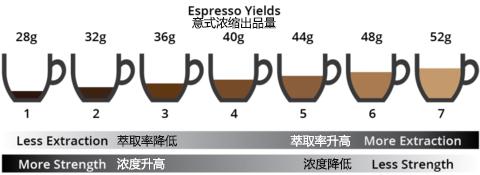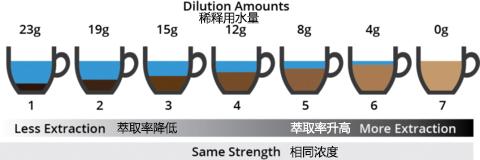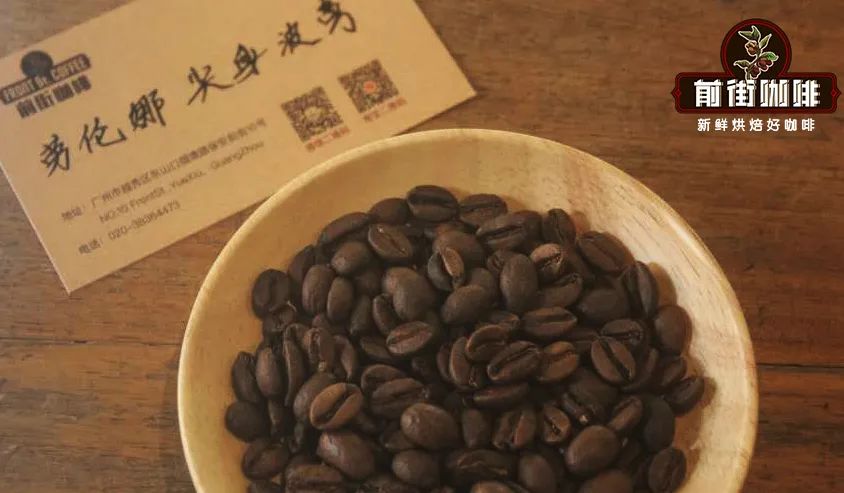Espresso tasting exercise course on testing the concentration of self-made espresso
For professional baristas, please follow the coffee workshop (Wechat official account cafe_style)
A taste test of espresso with different extraction rate
Coffee makers often have the opportunity to test multiple servings of coffee at the same time, which is an important part of their career development. For consumers, it is difficult to taste different coffees at the same time, so it is extremely difficult for them to develop a taste system. Many people in the coffee industry regularly do this many times a day to make rapid progress in taste training. But what hurts is that such a cup-after-cup test does not necessarily mean that you can learn and use it. You need to know why they taste different, or your mind won't be able to associate these variables with the effects they produce.
The two variables of extraction rate and cooking ratio are interrelated and are difficult to be analyzed separately. The purpose of this tasting experiment is to allow you to put aside the brewing ratio and only test the coffee flavor at different extraction rates.
You can do this test with any coffee and bean grinder. In fact, just use the coffee you often drink, not the quality, as long as it is as close as possible to the situation where you often taste coffee.
Step 1: Italian concentration
Start with the Italian concentrated cooking formula you often drink-it is likely to taste delicious and well-balanced, so it will serve as the middle value of the experiment. If you know the Italian concentrated cooking formula, that's great! If you don't understand, you need to weigh your powder filling and output.
Amount of powder filling = the weight of coffee powder in the cooking handle, in grams
Output = liquid weight of espresso in grams
Don't worry about the production time. As long as the bean grinder is adjusted and the coffee produced with your commonly used brewing formula tastes good, then the degree of grinding and the length of production time do not matter.
Before starting this experiment, the author strongly recommends that we first understand the general process of the experiment.
You will use the same amount of powder to make seven different quantities of espresso. The weight difference of each concentrated product is 4 grams, and your usual cooking formula is used as the intermediate value. For example, my usual Italian formula is 40 grams, and these seven portions are concentrated as shown in the following figure:

If you've never weighed a concentrated product, here's a quick start:
Grind the beans, weigh them, measure the cloth powder with the powder you usually use, and then press the powder. Weigh and fill the powder as accurately as possible.
Put your cup on the scale and return it to zero.
Start the extraction and concentration, and place the cup and weight under the boiling head.
When the Italian product is condensed, the weighing reading will also be increased. Stop the extraction when the weighing reading is less than 2-6 grams of the target product weight and let the espresso liquid in the brewing handle drip out.
Again, there is no need to change the degree of grinding, the amount of powder or the extraction time, which is not important here.
Seven servings of espresso are made according to this method, trying to keep the error between the product weight and the target weight within 1-2 grams each time.
In this way, you get seven espresso with different degrees of extraction and concentrations. The next step is to dilute the espresso so that their concentrations are very close.
Step 2: dilution
The largest amount of espresso is also the lowest concentration, so we need to dilute all espresso to the same concentration. Unfortunately, we cannot increase the concentration of Italian concentration, so this is the only way to concentrate 7 parts to the same concentration.
The concentrate with the least amount of production will have the highest concentration, so the amount of water needed for dilution is the most. As the output of espresso increases, the amount of water needed for dilution decreases cup by cup. Take the author's concentrated product scheme as an example, the following is the amount of water required for each cup dilution.

Now, you have seven espresso with very similar concentrations but very different extraction rates.
Step 3: test
Now is the time for testing.
First, divide your spaghetti into five groups:
1-2: serious insufficient extraction
3: moderate insufficient extraction
4: correct extraction
5: moderate overextraction
& 7: severe overextraction
Test the coffee and write down what's on your mind. No matter what smell you feel in your heart or taste buds, you can write it down. There is no incorrect description. The more honest you are to face a smell, the easier it will be to identify it the next time you encounter it.
These spaghetti concentrates will be lighter than you normally drink, so try not to think about the taste and mellow thickness. Accordingly, focus on the taste experience, the balance of sweetness, acidity and flavor.
Step 4: taste matching
I hope you can better feel the taste of your own condensed products after this experiment. Experiments like this are valuable for the development of taste senses and can speed up the matching of tastes with different concentrated extraction rates in your mind. And the sooner you can identify the taste flaws in the coffee, the faster you can correct them.

Important Notice :
前街咖啡 FrontStreet Coffee has moved to new addredd:
FrontStreet Coffee Address: 315,Donghua East Road,GuangZhou
Tel:020 38364473
- Prev

What is decaf coffee? What kind of decaf coffee do you have? Introduction to the types of decaf coffee
Professional coffee knowledge exchange more coffee bean information please follow the origin and development of decaf coffee in coffee workshop (Wechat official account cafe_style): why are all Swiss water treatment decaf coffee sold? Coffee is a necessary drink for many people every day, not only to boost their spirits or wake up, but also a kind of life, but many people are afraid that caffeine will keep them awake.
- Next

The effect of decaf on the body the difference between drinking decaf and regular coffee for a long time
Professional coffee knowledge exchange more coffee bean information please follow the origin and development of decaf coffee in coffee workshop (Wechat official account cafe_style): why are all Swiss water treatment decaf coffee sold? How much caffeine a cup of coffee contains depends not only on the variety of coffee beans, but also on coffee.
Related
- Beginners will see the "Coffee pull flower" guide!
- What is the difference between ice blog purified milk and ordinary milk coffee?
- Why is the Philippines the largest producer of crops in Liberia?
- For coffee extraction, should the fine powder be retained?
- How does extracted espresso fill pressed powder? How much strength does it take to press the powder?
- How to make jasmine cold extract coffee? Is the jasmine + latte good?
- Will this little toy really make the coffee taste better? How does Lily Drip affect coffee extraction?
- Will the action of slapping the filter cup also affect coffee extraction?
- What's the difference between powder-to-water ratio and powder-to-liquid ratio?
- What is the Ethiopian local species? What does it have to do with Heirloom native species?

